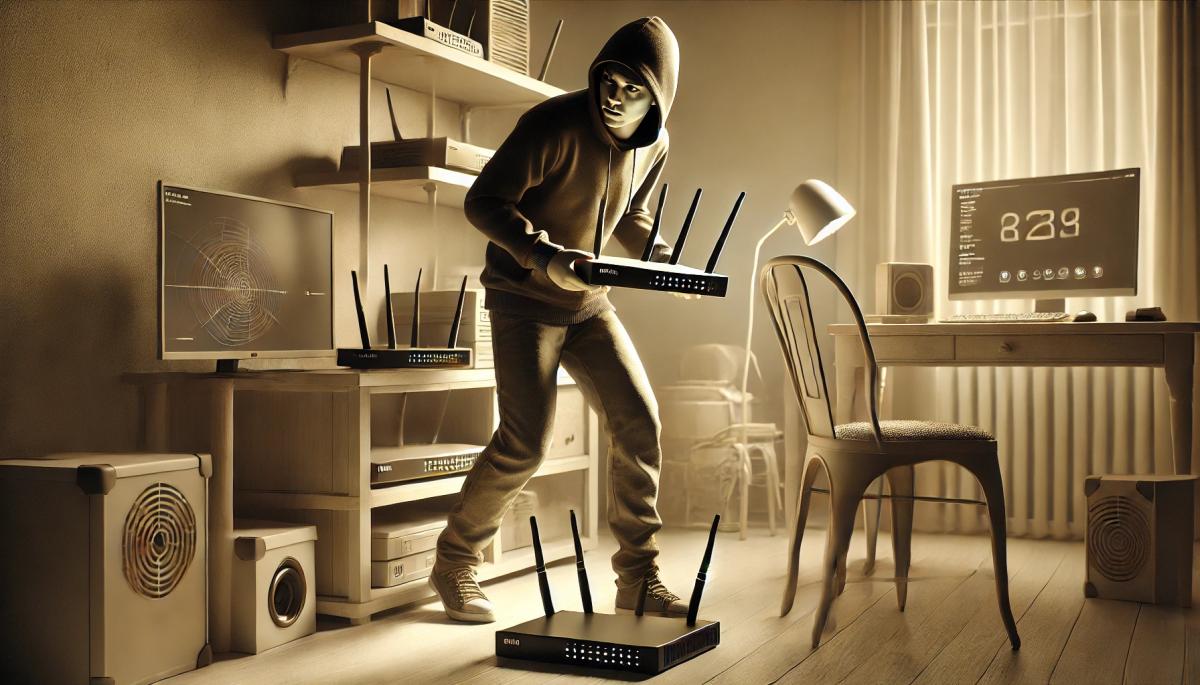The router is the key to protecting your home network. That's why it is targeted by most hackers, who can not only access your sensitive data and files but also use it for further attacks. Find out how to protect yourself from them.

The rise of online usage brings new security threats that most of us are not even aware of. One of the most underestimated parts of the home is indeed the router, through which hackers can easily penetrate your devices. Discover with us how you can better protect your data and privacy.
What threats are lurking?
Most people imagine hackers as the threat, using their clever tactics to break into your devices. But what specifically can threaten you?
Unauthorized network access
If your Wi-Fi is not sufficiently protected, anyone around can connect to it. Not only will this slow down your connection, but they can also gain access to your sensitive data, such as passwords, photos, or payment card details.
Man-in-the-Middle (MITM) Attacks
Man-in-the-Middle attacks allow hackers to “sit” between your device and router, where they can intercept and modify all data traffic. This means they can read your emails, monitor financial transactions, or even change the content of the websites you visit.
Using the router for botnets
Hackers can gain control of your router and incorporate it into a botnet—a network of compromised devices used for large-scale attacks like DDoS attacks on other servers or spreading malware. All this happens without your knowledge, which can have catastrophic consequences for you and your network.
Data leaks and identity theft
If your network is breached, attackers can steal your personal information, which they can then use to commit identity theft, such as accessing your online accounts, email, or banking services.
Ransomware
Attackers can infiltrate your network through unsecured devices and infect them with ransomware, which blocks access to your data until you pay a ransom.

5 mistakes that put your router at risk
-
Weak router password
A weak and easily guessable password is one of the most common reasons for successful attacks on home routers. Default passwords provided by the manufacturer are particularly risky, as attackers can easily get lists of them and thus breach access.
What you can do:
Create a strong, long password that includes a combination of uppercase and lowercase letters, numbers, and special characters. Ideally, use a phrase that is easy for you to remember but hard for hackers to break. Also, change the password regularly, especially if you suspect a network breach.
-
Outdated firmware
The firmware of your router, its “operating system,” is crucial for the security of the device. Router manufacturers regularly release updates that fix security vulnerabilities and enhance protection. Unfortunately, many users ignore them or don't even know they exist.
What you can do:
Regularly check if your router's manufacturer has released a new firmware version. If so, do not hesitate to download it. In some cases, you can set automatic updates directly in the router's administration.
-
Unencrypted Wi-Fi
Many people still use unsecured Wi-Fi networks or older encryption protocols that are easily breakable. Unencrypted Wi-Fi allows hackers to monitor all traffic, including login credentials, emails, and other sensitive information.
What you can do:
Choose WPA3 encryption if available. It is the latest and most secure standard. If your router doesn’t support WPA3, choose WPA2, but never use the older WEP.
-
Unauthorized access
We often don't realize how many devices are connected to our network. Each of these devices can pose a weak point if not adequately secured. Additionally, hackers can exploit connected unknown or foreign devices as a gateway into your network.
What you can do:
Regularly check which devices are connected to your Wi-Fi. You can find their list in the router's administration. Set up a separate network for guests, which will be isolated from your main network. This minimizes the risk of a visitor unknowingly bringing in malicious software.
-
Router as a target for botnets
As we have said, a botnet can incorporate your router into a large-scale hacking attack without your knowledge. Hackers often won't stop at just abusing your router; they will sooner or later attempt to steal your sensitive data.
What you can do:
Activate the firewall on your router. Most modern routers offer built-in protection against attacks. You might also consider using a VPN (virtual private network), which will provide your traffic with encryption and protect it from misuse.
Protecting a home network is not just about individual measures but about creating a robust defense on multiple levels. Hackers often target the smallest mistakes, so it's important to combine numerous security steps.
The key is continuous vigilance. You should not only monitor which devices connect to your network but also keep an eye on new security threats and regularly check the router settings. Developers constantly uncover new vulnerabilities, so it's important to keep up with them.
USB4 vs Thunderbolt 4: How Do They Differ and Which is Better?

Want faster connections and fewer cables? USB4 and Thunderbolt 4 are the future. Our article clearly presents what these technologies can do, how they differ, and which is best for you. Whether you're a gamer or a content creator, USB4 and Thunderbolt 4 make life a lot easier.
What are botnets and how can they turn your computer into a hacking weapon?

Botnets represent one of the most dangerous weapons of cybercriminals. These are networks of infected computers that are secretly controlled remotely. Your computer can become part of this army of "zombie" devices and be misused for DDoS attacks, spam distribution, cryptocurrency mining, or data theft. How to recognize that you are a victim and how to effectively protect yourself?
Optimizing the internet for a smart home: How to set up a network for IoT devices?

Looking for a way to ensure your smart home operates without interruptions and issues? Proper setup of a home network is crucial for the smooth operation of all connected devices. Our article will guide you through selecting the right router, its strategic placement, and optimal settings for different types of households.
5 alternatives to ChatGPT: Choose Your AI Assistant Tailor-Made

ChatGPT has changed the world of artificial intelligence, but it's not the only player in the AI assistant field. Discover five intriguing alternatives with different focuses – from analytical Claude to the versatile Gemini and the European Mistral. Each excels in different areas and offers you distinct functionalities.
AI in 2025: Everything You Need to Know About Artificial Intelligence

We will guide you through the basic concepts of AI, from machine learning to neural networks and natural language processing. You'll learn how to start practicing AI, which tools to use, and how to keep up with this fast-evolving field.
Ping vs FPS: What Slows You Down in Games and How to Fix It?

Ping and FPS are two key elements that determine the quality of your gaming experience. While ping reflects the speed of communication between your device and the game server, FPS determines the smoothness of the game's graphics. In our guide, you'll learn how to identify errors and how to easily fix them.